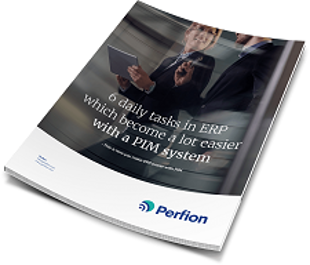
Face it, entering product data of new items or product lines from scratch is a drag. Especially if you keep your data in various files and systems, entering the necessary information can take like forever. Surely, there's a simpler way to manage product data?
Yes, there is.
A good Product Information Management (PIM) system incorporates something called data inheritance functionality. It's perfect for companies in need to automate many of the tasks associated with product data management, to save time and reduce costs.
Especially component manufacturers or others, whose products come with many different features, can benefit from a PIM system’s data inheritance functionality.
How Data Inheritance works in the Perfion PIM system
What is data inheritance?
Data inheritance works like this: When a user creates a new product in the PIM system, the product "inherits" the data it has in common with other products in the same product group. This way, the user doesn't have to enter lots of product information all over again.
Here's an example:
A manufacturer wants to enter data into his PIM system for a new line of products. Instead of entering all the complex specifics of the products, mass data inheritance fills in the gaps by obtaining the data of similar products from previous lines.
Although data inheritance serves organizations in almost every vertical, it's particularly useful for component manufacturers who often have large data sets in different systems.
|
|
What are product groups?
Manufacturers can group products into various categories. Here are some examples:
- Pumps
- Drills
- Coffee machines
- Table lamps
- Brand
- Price range
- Material
In each of the above groups, products will have similar features, as well as features that aren't so similar.
Why is data inheritance so valuable?
When manufacturers create new products in for example an ERP system or an Excel sheet, they need to enter all the products' features, which can be a time-consuming process. There is also a huge risk of human error.
A PIM system with data inheritance functionality, however, increases automation, saves time and reduces the risk of errors because the system has already acquired data from similar products. Only the specific data that differs for the new products must be entered manually.
How does PIM data inheritance solve the challenges of an ERP?
Using an ERP for Product Information Management can be challenging. Here's an example:
When a Product Manager enters product data into the ERP system, and there are no specific fields for some product features, the (already busy) IT department needs to create new fields, which can take significant time. Another thing is that it is necessary to start from scratch with a new product item every time.
Using a PIM solution with data inheritance functionality overcomes this challenge. Product Managers can add new products to existing product groups, which already contain products with similar features. In this scenario, Product Managers only have to fill in the remaining fields manually and they can even create new fields for new product features themselves — without the help of the IT department.
Perfion PIM as an example
The Perfion PIM system, for example, comes with data inheritance functionality and has already helped various companies manage their product data more effectively:
“The best thing about Perfion is the inheritance functionality. When we create a new product, we only have to fill in four data fields. The rest of the information is already given automatically through inheritance. It saves us huge amounts of time not having to re-enter all data from scratch every time,” says jewelry manufacturer Trollbeads. "Actually, the working hours saved - and the fact that we now have control of our master data - have alone been worth the investment."
The strong inheritance functionality makes the Perfion PIM solution especially suitable for Trollbeads' needs. Trollbeads is grouping products in many ways and the ability to define inheritance rules in the PIM system is a great time saver when new products are created in a group, as the product automatically "inherits" the data common to all products in the group. The remaining specific data is quickly entered.
Also Wentronic, a distributor of electronic accessories, is profiting from the mass data maintenance and inheritance functionality.
6 daily tasks in ERP which become easier with PIM
 Want to learn more about how a good PIM system can optimize your business tasks?
Want to learn more about how a good PIM system can optimize your business tasks?
Check out the guide “6 daily tasks in ERP which become a lot easier with a PIM system” where we go through six daily scenarios and illustrate the difference between working with either an ERP system or a PIM system.
 Six daily tasks in ERP, which become
Six daily tasks in ERP, which become 